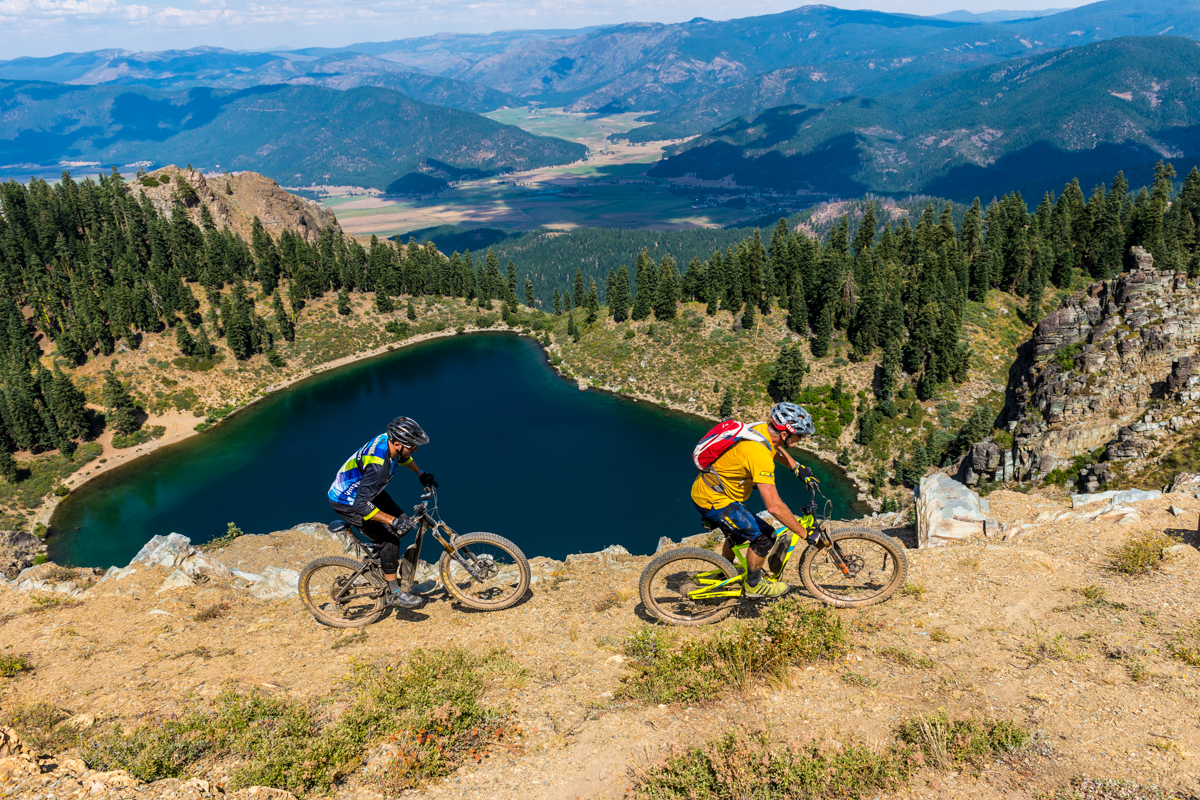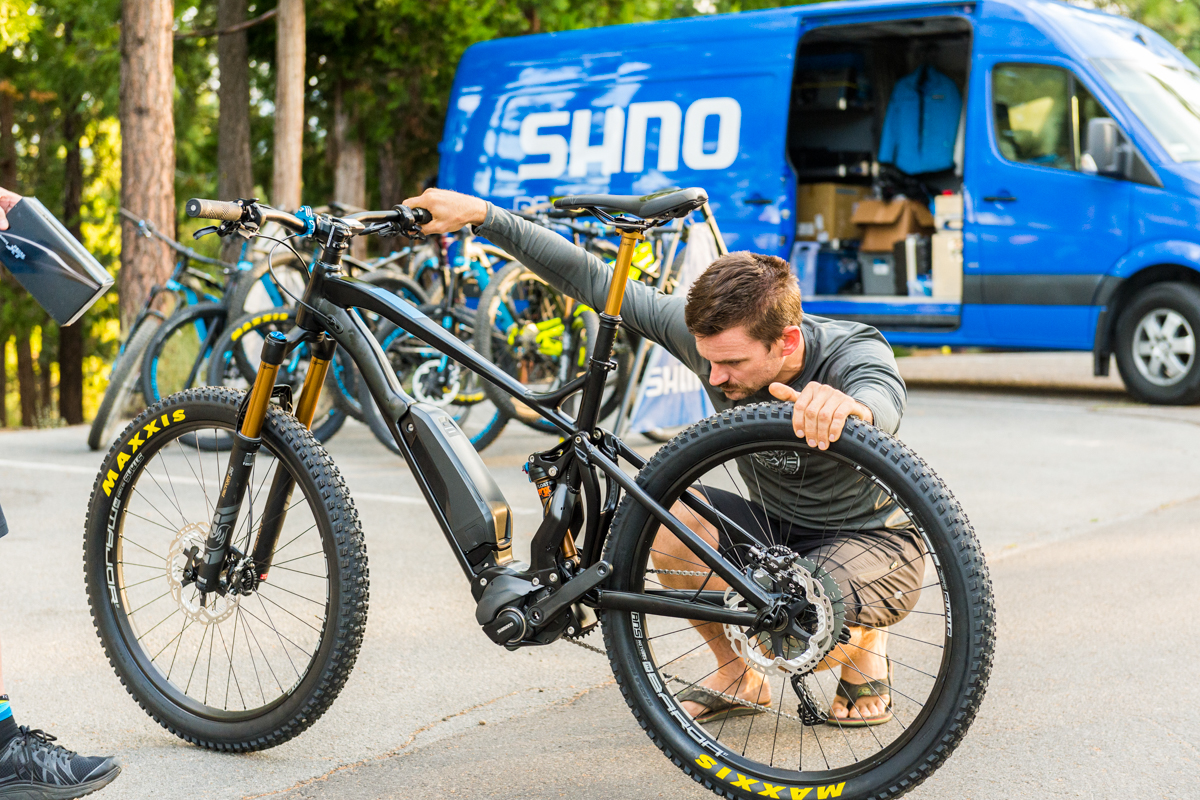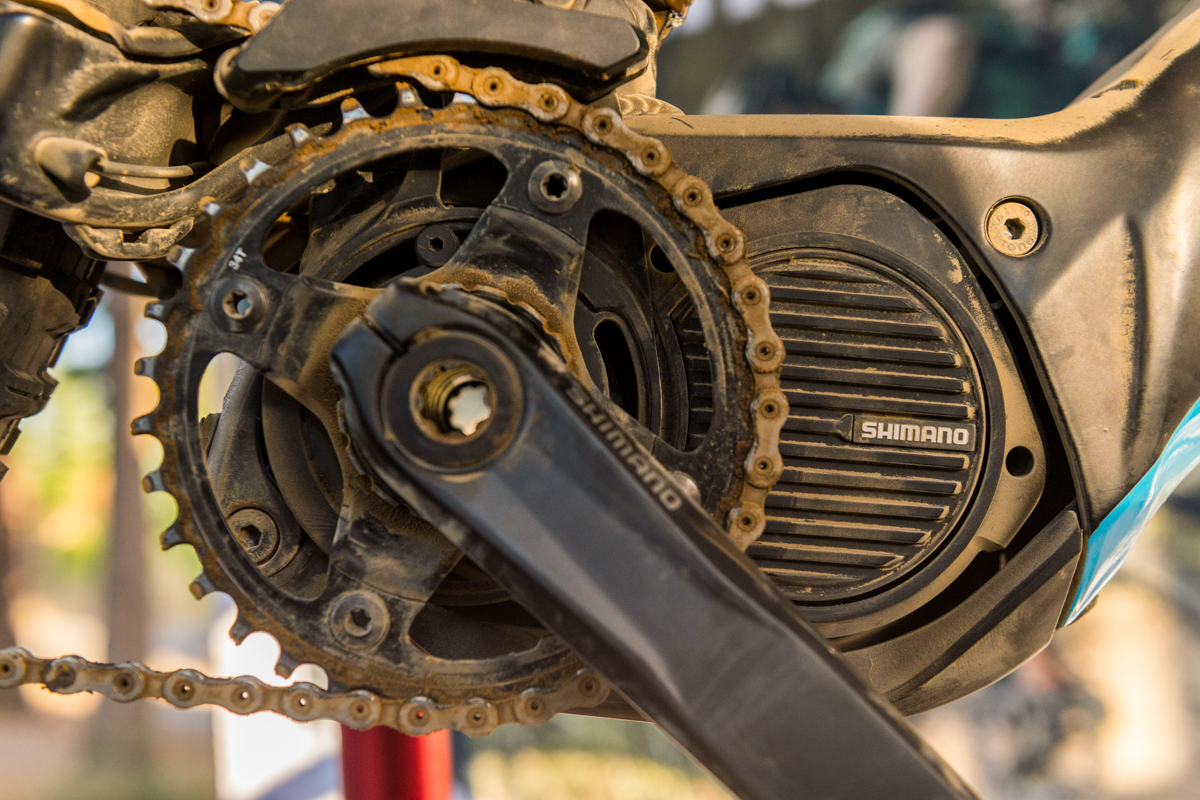Shimano Goes Electric: First ride on the E8000 STePS e-bike drivetrain
Originally posted on September 11, 2017 at 1:00 amWords by Kurt Gensheimer, photos by Colin Meagher
I’ve hauled ass down Baby Heads more times in my life than I can count, a thrilling high-speed jeep road descent that’s a staple of the Downieville Classic Cross Country race. It’s a trail that claims countless tires, rims and even bodies, because slamming into baby head size rocks at 30 mph can sometimes come to a violent conclusion.
But on this one particular August day, with rain pouring down, thunder and lightning all around and nine friends – some new, some old – we charged down Baby Heads with irrational exuberance. The experience was enriched with water spraying everywhere, the taste of damp Sierra Nevada dirt in our mouths and high-speed passes generating a few harrowing hoots and hollers. Of all the times I’ve ever descended Baby Heads, that day was among the very best. And we were all on electric-assist mountain bikes.

That last sentence probably ruined the entire story for some people, and some reading this might stop now and cancel their subscription to Dirt Rag. But as the old saying goes, “a mind is like a parachute, it only works when it’s open”. Unless you’ve actually ridden a motorized off-road bicycle (MORB), you have no grounds to hate on them. These contraptions are not the devil reincarnated, and the reality is that they’re here to stay and aren’t just going to magically disappear as much as some wish they would.
So instead of keeping our heads buried in the sand, the better we understand exactly what MORBs are, the better we can figure out how they fit into the bigger multi-use recreation picture. Although I will always prefer 100 percent human powered mountain bikes and advocate for them first over power assist, there are other people in this world besides me who might find a MORB appealing. And in the interest of keeping an open mind, I rode a MORB 60 miles with 10,000 feet of climbing over two days, and dare I say, it was one hell of a good time.

Introducing Shimano E8000 STePS
Of all the places in the United States to launch their new E8000 STePS e-bike drivetrain, Shimano chose Downieville and the Mount Hough trail network in nearby Quincy for its extensive network of motorized-legal trails with huge elevation gain and terrain that pushes the limits of all bike equipment.
Maintained and constructed by the Sierra Buttes Trail Stewardship, the northern Sierra Nevada region an hour north of Lake Tahoe – known as the Lost Sierra – is a true multi-use recreation destination. Thanks to the Stewardship, there are trails for all users in the Lost Sierra, including moto riders, mountain bikers, equestrians, hikers, and yes, even e-bikers. For many folks, the prospect of climbing to the top of the Sierra Buttes – more than 7,000 vertical feet above Downieville – is not within their physical reality, which is why many choose to ride the Yuba Expeditions shuttle. So if there’s any destination to put an e-bike drivetrain to the test, it’s the Lost Sierra.

Shimano’s primary goal in building an e-bike drivetrain was to make it light and compact enough so the end product feels more like a mountain bike than an electric-assist bike. Examples of this philosophy include using a traditional Shimano XT crankset with the same Q-factor as a mountain bike, a very compact drive unit that allows frame builders to use shorter chainstays for quicker handling, and the seamless integration of Di2 shifting with the powertrain. The powertrain consists of a premium quality, fully waterproof 504Wh lithium-ion battery and a compact, seven-pound drive unit with 70Nm of torque.

But what really sets the E8000 system apart from all other electric assist systems is the way Shimano designed assist mode selection. Since the 11-speed system does not require a front shifter, Shimano uses a FIREBOLT left-side shifter, switching between Eco, Trail and Boost modes, as indicated on a slick bar-mounted LCD readout showing gear and mode selection, different speed and distance parameters and remaining battery range based on usage. Unlike competitors that require reaching the down tube to change modes, the Shimano system delivers different assist modes with the push of a button without hands ever leaving the bars. And for those tech geeks, Shimano offers a smartphone app that can customize the specific Eco, Trail and Boost output levels.
In addition to the three modes, there’s also a very clever Walk mode, engaging when the rider holds down the left side shifter lever, enabling the rear wheel to automatically turn at three miles-per-hour, helping the rider walk up super steep grades, not unlike a self-propelled lawnmower. And if the system senses any pressure on the pedals, Walk mode is automatically disengaged. It might sound lame, but when you’re pushing a 45 pound bike up a steep pitch, Walk mode is much appreciated.

Shimano figured out the reason why previous 11-speed mountain bike-specific drivetrains broke chains on ebikes so often; inadequate plate to pin design that couldn’t hold up to increased torque loads under shifting. As a result, Shimano redesigned their 11-speed chain with thicker end plates, preventing breakage. And over the course of four days and 120 miles of trail riding, there wasn’t a single broken chain to be reported.
Shimano put their E8000 system on an aluminum trail bike designed by Taiwanese manufacturer ASTRO, which produces e-bikes for Mondraker. The 150mm front/140mm rear travel trail bike was also equipped with a Fox 36 fork and Float rear suspension, specially tuned for the heavier weight of an ebike. In order to provide the best overall riding experience, Shimano and Fox worked closely together developing quite a capable e-bike system.

The Ride
Of course the E8000 system makes riding uphill much more agreeable and social. There couldn’t have been a better example of this than 12 riders across a wide range of skill, fitness and experience levels all staying together, holding a conversation while riding the infamous “Trail of Tears” climb on the Downieville Classic course from Sierra City to Packer Saddle; a seven-mile, 3,000 vertical foot climb that crushes peoples’ dreams. Having the mode selector at the touch of a button made climbing much more dynamic, shifting dozens of times between modes to match the output of other riders. Say what you want about e-bikes, but these machines absolutely make climbing more approachable and social for more riders; it’s the ultimate equalizer.

Perhaps more impressive was how well the ASTRO-built bike with its e-bike optimized Fox suspension performed downhill. Although 45 pounds sounds like a lot, it’s five pounds lighter than the Specialized Levo, which is significant. This is was most noticeable when descending Baby Heads, Pauley Creek and Third Divide trails. There were times I forgot I was on a 45 pound bike, that is until I ripped into a high speed corner and felt the front end plowing like a bulldozer. It’s still an e-bike, but the best descending e-bike I’ve ridden to date.

The biggest question mark in my mind before the ride was battery life. I was quite impressed to see after 30 miles and 5,000 vertical feet of climbing in Downieville I still had two bars out of five on the 504 Wh battery, equating to nearly 10 more miles of riding. And after 30 miles and 5,000 feet of vertical on Mount Hough Trail in Quincy, I was down to a single bar; but I used Trail mode almost the entire time on the long climb up, with numerous episodes in Boost mode. Boost mode really has some good kick for those uphill moments when you’re on the edge of not making it, and even after pedaling, Boost gives a final quarter turn of push before disengaging. Ultimately, battery life comes down to energy management, and riders who keep it in Eco mode most of the time can expect to get at least 35 miles and more than four hours of riding before depleting the battery.

Final Thoughts
Did I have fun on this Shimano-equipped e-bike? Absolutely. Will it replace my mountain bike? No way. The following day I pulled out my good old 100-percent human powered mountain bike and went for a ride. I was nervous at first that I’d miss the power assist; the hand of God pushing me up the climb, but I didn’t. You know what else I didn’t miss? The constant humming sound of the electric drivetrain and the constant looking down at the LCD readout to see what mode I was in and how much juice I had left.
The other thing I noticed pedaling my mountain bike was that my legs were indeed tired from two big days on the e-bike. Whoever says you can’t get a workout riding an e-bike is full of it. You absolutely can. Regardless, there’s still something amazing about pedaling under your own power to the top of a mountain. Maximum work for maximum reward, which for me equates to extra earned beers. And as long as you have the time and the energy, who cares if it takes longer to get to the top than if you pedal an e-bike? I got the time and I got the energy, so at least in the foreseeable future, the e-bike won’t be driving my pedal-powered adventures.
But for trail builders who need a quick way to get out and do trail work, older folks who want to keep up with their younger friends and those with life-altering injuries, the e-bike makes perfect sense. I just hope that e-bike manufacturers realize the conflict they are creating by trying to call these devices mountain bikes, because they’re not. And I also hope e-bike manufacturers get engaged with land managers, figuring out ways to raise money for new, e-bike legal trails while responsibly incorporating e-bikes on non-motorized trails only where they make the most sense. So long as the growing e-bike industry can take responsibility and bring their own advocacy dollars to the table, I don’t see anything wrong with the incorporation of this new way to recreate in the outdoors.
